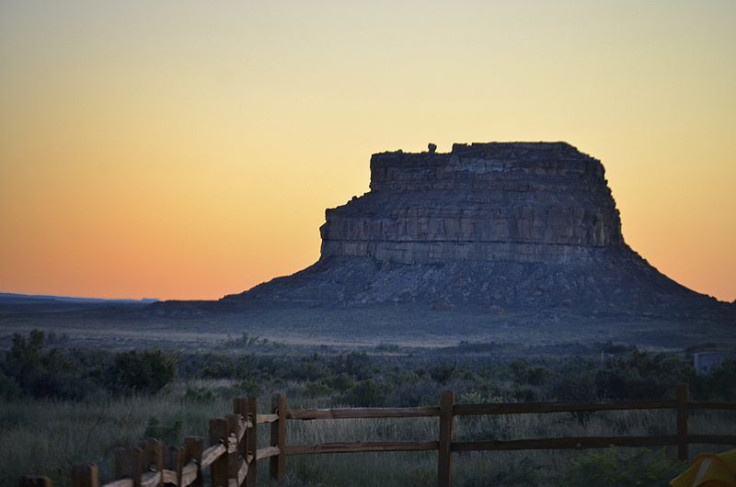Summer Solstice, Native Americans, And The Tradition Of Renewal

From the Latin words for "sun" and "to stop" comes our word "solstice." On solstice, the sun does appear to pause in the sky when it reaches its northernmost point, which occurred at 1:04 a.m. EST on June 21. Throughout time, the year's longest span of daylight has been marked and celebrated by many different cultures. Among the most interesting rituals are those of the native American tribes.
Original Observatories
Some scholars believe that the arrangement of stones built several hundred years ago by the Plains Indians on the top of Wyoming's Big Horn Mountains is a tribute to the summer solstice. The "medicine wheel," with a diameter of 80 feet, aligns with solstice sunrise and sunset. At the center is a doughnut-shaped pile of stones (a cairn) connected to the rim of the outer circle by 28 spokes of stones. Six more stone cairns are arranged around the circle, most large enough to hold a sitting human. Each orients a person to certain places on the distant horizon that indicate where the sun rises or sets on summer solstice. The structure is only reachable during the warm summer months as it was built at the top of the mountain range at 9,642 feet.
Between 70 and 150 wheels have been identified in South Dakota, Wyoming, Montana, Alberta, and Saskatchewan. It is believed that the Bighorn "observatory" is simply one part of a larger configuration of interrelated archeological sites that represent 7,000 years of Native American cultural adaptation to their landscape.
Another significant structure is located in Chaco Canyon, an arid valley in New Mexico. Fajada Butte rises nearly 148 yards above the canyon floor and is known to contain a solar marking site that records the equinoxes and solstices. The structure includes three slabs and spiral petroglyphs, which cast shadows and shafts of light to indicate the cycles of both sun and moon. According to tradition, Fajada Butte is sacred ground. Probably constructed by ancient Pueblo Indians, Fajada Butte may have been the center of a complex society of precolumbian culture and the site of celebrations and native ceremonies.
Sun Salutation
Many, if not all, of the native American tribes performed ceremonies focused on summer solstice. The sundance, believed to have originated with the Lakota tribe, is a ceremony that lasted 28 days, with a final four to eight days of intense festivity. Although the ceremonies varied in form from tribe to tribe, many had features in common, such as dancing, singing and drumming, prayer, meditation, the experience of visions, fasting, and skin-piercings. The Arapaho, Arikara, Asbinboine, Cheyenne, Crow, Gros, Ventre, Hidutsa, Sioux, Plains Cree, Plains Ojibway, Sarasi, Omaha, Ponca, Ute, Shoshone, Kiowa, and Blackfoot are among the tribes that celebrated.
The sundance was generally outlawed in the latter part of the nineteenth century because of the perceived aspects of self-torture. Typically, a dancer was pierced through the skin and connected by ropes and pegs to either a tree or a stake around which he would dance until the pegs or the piercings broke. Symbolic of death and renewal, the dancer was believed to be reborn mentally, spiritually, and physically. The ceremony as a whole spoke to the continuity of life; it was meant to convey a cycle of regeneration wherein all of nature is intertwined.
Not an uncommon belief for summer solstice, which has been celebrated by the ancients around the globe.
Other Traditions
The ancient Chinese believed the sun was exactly in the middle of the sky, without slant, at noon on summer solstice; thus, they marked this moment as the beginning of summer. For summer solstice, they participated in ceremonies to honor the earth, femininity, and the force known as yin in contrast to winter solstice rituals, which were devoted to the heavens, masculinity, and yang.
Among the Ancient Greeks, summer solstice meant celebration, including rituals for a festival in honor of the agriculture god Cronus. Abandonging their social codes, slaves participated as equals and were often served by their masters. For Greeks, the summer solstice also marked a one-month countdown to the opening of the Olympic games. Meanwhile in the days leading up to summer solstice, the Ancient Romans paid tribute to Vesta, the goddess of the hearth. Roman rituals included the removal of an unborn calf from its mother's womb and subsequent sacrifice.
Midsummer was a crucial time of year for Vikings, Nordic seafarers, who would meet to discuss legal matters and resolve disputes around the summer solstice. They would also visit wells thought to have healing powers and build huge bonfires. This tradition of rejoicing by the side of bonfires was also practiced by Germanic, Slavic, and Celtic pagans; this tradition is still enjoyed in Germany, Austria, Estonia, and other countries today.
Stonehenge
It is believed the Druids, Celtic high priests, led ritual celebrations during midsummer. Although popularly people believe this took place at Stonehenge, the stone circle located in Wiltshire, England that is estimated to have been built around 3,100 BC, historians say that this is not the case. Constructed in three phases and requiring more than thirty million hours of labor, Stonehenge is made of bluestone, sarsen, and Welsh sandstone. The reasons Stonehenge was built are unknown, though speculation ranges from human sacrifice to astronomy.
Ignoring the historians, many contemporary pagans and simple partiers congregate at Stonehenge to celebrate solstice; in fact, Fox News reported more than 20,000 celebrants have gathered at the famed Stonehenge monument to mark the occasion today.
Source: Sofaer A, Sinclair RM, Doggett LE. Lunar Markings on Fajada Butte, Chaco Canyon, New Mexico. Archaeoastronomy in the New World. 1983.



























